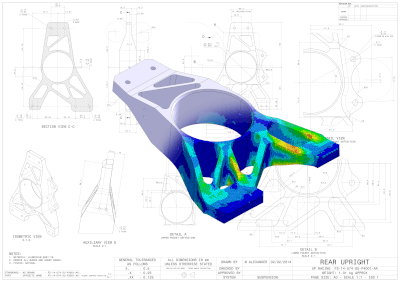What Is Stress Analysis Software?

Stress analysis software is software that simulates the stress on an object.
Stress is the force per unit area applied to the interior of an object (internal force per unit area). When an object undergoes deformation, stress is applied to the object in order to deform or rupture it. However, it is impossible to visually verify the stress applied to the object’s interior during this process.
Therefore, stress analysis software is used to analyze the stress in an object using a computer and to verify whether the object can withstand the stress.
Uses of Stress Analysis Software
Stress analysis software primarily serves to assess and confirm the structural strength. For instance, when designing a machine, it is used to ascertain the forces acting on the structure in order to evaluate its resilience. The structure and materials of the machine are reviewed and redesigned for higher strength.
In the days when stress analysis software was not available, the designed machine was actually manufactured and stress analysis was performed by experiment. However, the time and cost of conducting experiments each time was too much. The stress analysis software has reduced the time and cost of such experiments.
Principle of Stress Analysis Software
The basic principle of stress analysis software consists of the finite element method (FEM). The finite element method is “a mathematical method for solving differential equations in an approximate manner.”
When analyzing an object on a computer, it is necessary to represent (model) the properties of the object with mathematical equations, as computers can only process mathematical equations. The method to model the structure and properties of an object in an approximate manner is called the finite element method. In the finite element method, an object with a complex structure and properties is divided into a finite number of elements.
For example, in the Tokyo Tower, a complex structure can be easily approximated by dividing each red bar. One finite element can be represented by a relatively simple mathematical formula. Each micro-region that is divided is represented by a mathematical formula, and by connecting them together, the properties of the entire object are approximated. In other words, a complex structure is divided into a finite number of small elements, and the stresses and displacements of each element are determined. Then the whole structure is joined together.
The finite element method (finite element analysis) is a method to analyze the displacement and stress of an object by modeling the structure and properties of each finite element and adding them together, considering a single complex object as a whole.
Additional Information on Stress Analysis Software
Forces can be broadly divided into external and internal forces. The internal force per unit area is called stress.
1. External Force, Internal Force, and Stress
External Force
External forces are forces acting outside of an object. For example, an external force is a force that pulls a member, such as a bar, from the outside by a surface in contact with it. Since external force is a force applied from outside the object, it is generated by the act of pulling by hand or compressing by a machine.
Internal force
Internal force is a force acting inside an object. When a member to which an external force is applied is hypothetically cut, an inner force is generated to balance the external force. While external force is a visible concept through actions such as pulling by hand, internal force is important in evaluating objects’ deformation and fracture.
Stress
Stress is the force per unit area applied to the interior of an object. As a result, the unit of measurement for stress is not the unit of force [N] but [Pa], which is the same as the unit for pressure. An object subject to an external force generates an internal force to counterbalance the external force. Therefore, the greater the external force applied, the greater the internal force it generates.
When considering the deformation or rupture of an object, attention is paid to the internal force. However, since the dimensions of the member cannot be taken into account only by the internal force, stress, which represents the force per unit area, is calculated by dividing the internal force by the area. By using stress, the load on an object can be verified regardless of the size of the object.
2. Types of Stress
Stress can be broadly divided into two types: tensile stress and shear stress.
Tensile stress is the stress produced when an object is pulled and is uniformly distributed across the hypothetical cut surface of the object. Shear stress is the stress that acts when an object is sheared. For example, when cutting cardboard with scissors, shear stress is generated in the scissors and cardboard because shear cuts the cardboard.
Combining tensile and shear stresses can address complex problems. For example, if you hold both ends of a carrot with both hands and make a bending motion, tensile and shear stresses are applied to the center, causing the carrot to break near the center.
If the same thing were to occur in a structure such as a bridge, it would cause a major accident. To avoid such a situation, stress analysis software should be used to verify what stresses are applied to the object.